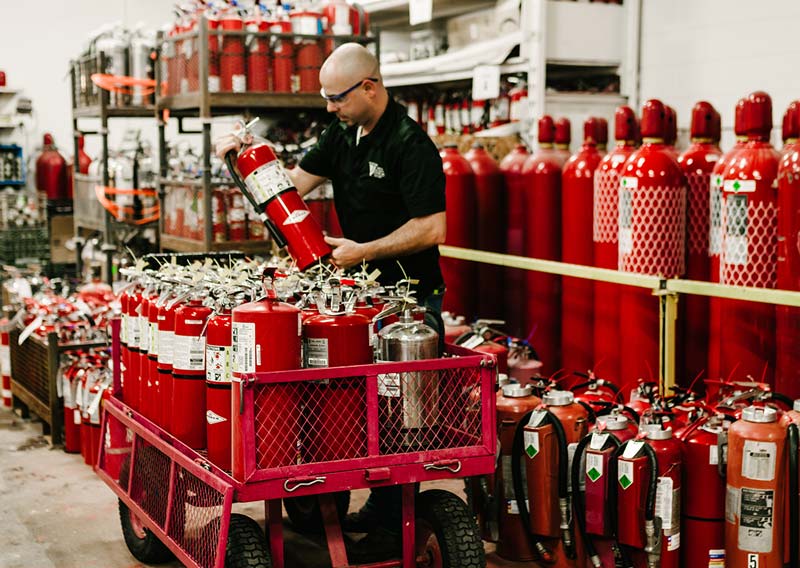When you manage a large facility or building, there are many components to keep track of. From general maintenance to specialized components like your fire suppression system, it might feel like you always have some type of preventative maintenance or test scheduled. One essential test that’s easy to miss is hydrostatic testing for your fire extinguishers. Here’s what you need to know hydrostatic testing, including what it is, and how often your fire extinguishers should be tested:
What is Hydrostatic Testing of Fire Extinguishers?
Hydrostatic testing is completed on rechargeable fire extinguisher tanks to evaluate the cylinder’s ability to hold pressure. Hydrostatic testing checks for leaks and overall strength, and is completed to ensure the safety and effectiveness of a pressurized fire extinguisher.
How Often Do My Fire Extinguishers Need Hydrostatic Testing?
Hydrostatic testing is required for nearly any kind of rechargeable fire extinguisher, but the type of extinguisher you have will dictate how often hydrostatic testing is required.
In general, hydrostatic testing is required:
- Every 5 years for pressurized water, carbon dioxide, and wet chemical fire extinguishers.
- Every 12 years for dry chemical fire extinguishers.
To make sure you’re testing your fire extinguishers on schedule, it’s a good idea to take a quick walk around your facility and verify what types of extinguishers you have. While most facilities make use of common ABC fire extinguishers, a type of dry chemical fire extinguisher, it’s possible to have a few different types of extinguishers installed in your facility, especially if you have a kitchen or unique hazards present in your workplace.
What Are the Steps of Hydrostatic Fire Extinguisher Testing?
Many facilities managers are familiar with regular fire extinguisher tests and inspections, but because hydrostatic testing is so infrequent, it’s not as well known. If you’re wondering what happens during a hydrostatic test, here are the basic steps.
*Note: It’s important that any hydrostatic fire extinguisher testing be completed by individuals and facilities certified for hydrostatic testing. If you’re not sure where to have your hydrostatic testing completed, talk to the Vanguard team.
Step 1: Visually Inspect Fire Extinguisher
Before a fire extinguisher can undergo hydrostatic testing, it should first be inspected. We start with an inspection of the extinguisher’s exterior. Anything that could compromise the integrity of the cylinder, from corrosion to deep dents, means that the extinguisher cannot be safely tested, and should be removed from service.
Step 2: Discharge Extinguisher
Once the extinguisher has been visually inspected, it’s time to discharge it so your hydrostatic testing professional can inspect the interior of the cylinder as well. The extinguisher’s hose is removed and replaced with the hydrotest/recharge adapter. Then, the extinguisher can be fully discharged. After the extinguisher is empty, the hydrostatic testing technician will remove the valve and blow out any remaining traces of agent with an air hose.
Step 3: Inspect Fire Extinguisher’s Interior
Once the fire extinguisher is fully empty, it’s time to inspect the interior. Again, the hydrostatic testing technician is looking for any flaws in the cylinder that would indicate the fire extinguisher cannot maintain pressure. If any pitting or flaws are identified, the fire extinguisher must be permanently removed from service.
Step 4: Run the Hydrostatic Pressure Test
If the fire extinguisher passes both visual and interior inspection, it can be safely tested. The NFPA 10 requires the use of water for all hydrostatic testing, and the cylinder must be tested within a protective cage or behind a protective shield to ensure the technician’s safety.
The function of a hydrostatic test is to ensure that your fire extinguisher can still withstand its pressure rating. When a fire extinguisher undergoes hydrostatic testing, it is filled above its pressure rating with water.
At that point, the technician monitors the cylinder, looking for any drop in pressure. A drop in pressure during the hydrostatic test indicates that the fire extinguisher has a leak, and should be permanently removed from service.
If a fire extinguisher fails the hydrostatic test, it cannot be put back into use.
Step 5: Putting Your Fire Extinguisher Back In Use
If the fire extinguisher is able to maintain pressure throughout the test, it will then be drained, cleaned, and dried. The fire extinguisher technician will replace disposable parts like the extinguisher’s old valve stem and O-ring, and refill it with the appropriate extinguishing agent.
Once your fire extinguisher is refilled, the technician will replace the service collar, ID, and labels, repressurise the extinguisher, and install the tamper seal and hose. At this point, your fire extinguisher is ready to return to service.
Hydrostatic testing is an essential component of your facility’s fire safety maintenance program, but with a testing requirement of just once every 12 years, it can be difficult to stay on track. If it’s been some time since you’ve looked at your fire extinguisher’s service label, now might be a good time to check. Another great way to make sure your facility is always on time with regular maintenance is to partner with a fire protection contractor who can put you on their schedule so you never miss a test.
Whether you’re looking for a certified hydrostatic testing facility or you’d just like to schedule regular maintenance for your fire extinguishers or fire suppression system, Vanguard Fire & Security Systems is here to help. Get in touch with our inspection, maintenance, and testing team to learn how we can help you.


